BlogRSS
Europeana Fashion Focus: “Nodini” Sandal by Salvatore Ferragamo,1939.
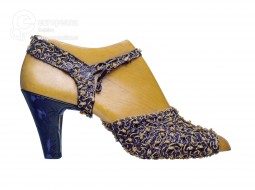
The “Nodini” Sandal is made of cellophane and wicker, in the shades of blue and yellow. It belongs to the 1939 summer collection designed by Salvatore Ferragamo and represents one of the first models of shoes realized with that material.
Fashioning fun: Jean-Charles de Castelbajac
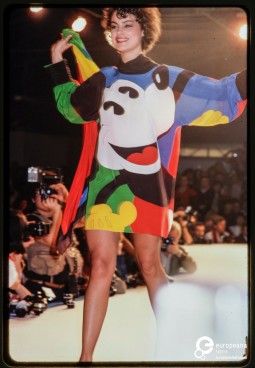
Since his earliest collections, fashion designer Jean Charles de Castelbajac has been a master of the divertissement, conveying in his designs a fascinating mix of fun, surrealism and counter-thinking.
The unbelievable exaggeration: Incroyables and Merveilleuses
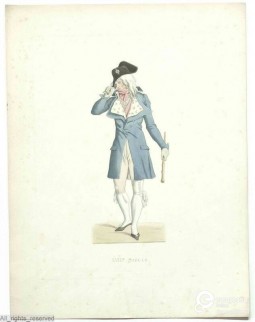
Emerged in Paris in 1794 during the period of the French Directory, which followed the execution of Robespierre, the Incroyables formed a new social group among the aristocracy, setting themselves aside through to their flamboyant fashionability.
The term ‘Incroyables’ means ‘incredibles’, while their female counterparts were the Merveilleuses, roughly the equivalent of “fabulous divas”. Affected by the Reign of Terror and in a need to reconnect with other survivors, they launched an outbreak of luxury, decadence and even silliness, introducing exaggerated fashion trends in clothing and overall style mannerisms. The desire to break up with the regrettable events connected to the Revolution was so strong that some devotees of the trend preferred to be called ‘incoyable’ or ‘meveilleuse’, thus avoiding the letter R, as in ‘révolution’.
The members of this group were young, the political product of an explosive time in history. They basically made their statement by dressing in outlandish fashions that mocked the luxurious styles worn in the court of King Louis XVI. The Incroyables wore eccentric outfits with large earrings, wide trousers, huge neckties, thick glasses, hats topped by so-called ‘dog ears’ and large monocles. The Merveilleuses instead exaggerated the Greek style and its neoclassical revival, wearing loose gowns made of almost transparent sheer fabric. The gowns displayed cleavage and were too tight to allow pockets. With this ‘naked’ look they used to match small bags, enormous hats, short curls like those on Roman busts, and Greek-style sandals.
Everything in their appearance was a comic exaggeration, which came out as an undertaken rebellion against the serious and repressed atmosphere. Their style and attitude made them look like lavish and ridiculous caricatures of the nobility before the revolution. They frequently faked a lisp, took up a stooped hunchbacked posture and used postiches as fake disfigurements. The Incroyables arrived also at pulling up their hair in the back with a comb to imitate the hairstyles of the condemned. The Marvalleuses used to have shaved heads under their blonde, black, blue or green wigs, which had been banned by the Paris Commune. The both of them wore large amounts of heavy musk perfume, which led some to call them “muscadins”.
This strange and ‘unbelievable’ trend ended at the beginning of the 1800s, when Napoleon Bonaparte rose to power: society took a more sober and modest turn, while discouraging any kind of opposition, above all the stylistic ones, conflicting with the view of the emperor.
Cameos: Minuscule Marvels
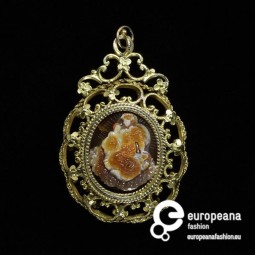
The word ‘Cameo’ refers to an engraving technique opposed to intaglio. it has become common to use the same word to define the gemstones engraved with that particular techniques, and the jewels made out with them. Their value lays in their striking beauty, which in turn comes from the intriguing relationship between small size and huge complexity.

Reliquary pendant made of onyx, early seventeenth century, Courtesy Victoria and Albert Museum CC BY SA
The production of cameos dates back to the Greek and Roman periods, when they were made from semi-precious gemstones,particularly onyx and agate. In more recent times, other materials, such as shell and glass, have been used in order to respond to the demand of consumers. These kinds of cameos were popular in the sixteenth century; following the revival of classical motifs brought up by Neoclassicism, between eighteenth and nineteenth centuries cameos returned to be a desirable item in Europe, causing a sort of explosion in the production of cheaper versions of the semi-precious ‘originals’. Of course, materials created different categories of objects, which then defined people owning the cameos: the most precious were also the ones requiring more skill and ability, and were displayed by the higher strata of society.
Cameos are made by cutting away background material to make a design in relief. The technique is really complex and the ability of the artist lays in turning the natural flaws and layers into precious details that mark the uniqueness of the piece itself. That is how the quality of a cameo is judged: by the accuracy of the design, the smoothness of its lines and the grace of the overall appearance of the object. In their ‘artificiality’ – their double essence of natural stones reshaped by skilled craftsmen – cameos can be considered an example of how human work can act on nature and, in some ways, change it according to taste and desires.

Golden pendant enamelled and set with an onyx cameo of Marie de Medici by Georges Bissinger, 1865, Courtesy Victoria and Albert Museum CC BY SA
Given the importance of the human factor, cameos developed as a techniques but turned quite quickly into an art; interestingly, the artistic value wasn’t that much in the creativity in the choice of the motif, but more in the manneristic attention for displaying the technique, made even more difficult by the size and preciosity of the gemstone. As for the motifs, many craftsmen were either copying antique pieces or reproducing popular designs selected by their clientele; one particular motif that was widely used was the portrait, which could either recall eminent personalities of the past, celebrate contemporary icons or indeed, acquainted and loved ones.
The mannerism enclosed in such care for details takes full form into the rather minuscule space of the cameo, which from its exteriority seem to acquire at least part of its value. In terms of use, cameos, once considered pieces of art that were to celebrate events and important personalities, were also used jewels by male and females alike. Brooches, pendants and rings were the most common montages for cameos, which were donated as gifts and also bought as souvenirs of travels and Gran Tours, circulating within different nations and acquiring new meanings according to their forms and diffusion.
Thanks to our content provider, the Europeana Fashion Portal holds many exquisite examples of cameos: brows the collection and dive into the microscopic grandiosity of these objects.
Miniature shoes

The fascination with miniature shoes has its roots in ancient times. Miniature sandals have been found in Egyptian tombs, fashioned from ancient Persian pottery. The Romans had oil lamps shaped as a foot in a sandal and perfume containers as hob-nailed boots. Funeral jars kept in memory of the dearly departed were also made in the shape of boots.
In eighteenth century Europe, it was regarded the height of a shoe maker’s professional career to display the ability to recreate the shoe design in miniature with all the same details and elegance of the original models. This became a necessity for most shoemakers when a trend was formed due to the upcoming wedding of Prince Frederick Augustus, Duke of York to Frederica Charlotte Ulrica Catherina, towards the end of the century. Unfortunately Frederica was not considered highly desirable, however the Prince was infatuated by her very tiny feet. During their engagement, the prince had six pairs of miniature shoes promptly made by the royal shoemaker. During that period, newspapers were unable to report on Frederica’s physical appearance, so instead made headlines based upon her petite shoes. The media interest resulted in the production of hundreds of these miniature shoes. They became one of the most sought after fashion item of the time; they were even bought despite the size of the costumer’s feet, and rather used as pin cushions or ornament for the household.
In 1984, George du Maurier published the novel Trillby, the story of an Irish girl who goes to Paris and falls under the control of an hypnotist named Svengali. One of the girl’s eccentricities was to flash her bare foot in public, which was considered a rude custom at that time. The enormous success obtained by the novel encouraged the manufacture of miniature shoes and brought the trend within the reach of Victorians of all classes, who started to collect several object in the shape of shoes. Victorian gentlemen had shoes fashioned as gin flasks, umbrella handles, paper knives, ink wells, accessories associated with smoking and snuff taking; while women had pieces of jewellery, comb handles, bonbonnieres and needlework accessories. During nineteenth century, the popularity of all things oriental draw to the west miniature porcelain examples of the so-called ‘lotus shoes’, which could be found as keepsake in many European houses.
This leads to look for the ‘material results’ the interest in feet and their size produces outside Europe. In ancient China, for instance, women’s small feet were considered a feature of beauty; foot shape and foot size were so important to become one of the standards to judge a woman’s beauty. To prevent the natural growth, the custom of binding little girl’s feet at the age of 5 was introduced by the tenth or eleventh century among upper-class court dancers, and soon became popular as a means of displaying status. Whether a woman had bound feet or not, and how she bound them, it directly affected her marriageability. To re-shape the girl’s feet, a long strip of cloth was used to bind them, breaking them off and bending them into the arch of the foot, so as to form a pair of “four-inch es golden lotuses”. This practice used to cause lifelong disabilities, but it was not until the early 20th century that foot-binding fell into disuse.
As many artifacts in museums and collections show, throughout the centuries miniature shoes became tokens of many meanings and symbolised a desire to share worldly goods; when the growth of railways allowed travel to resorts, souvenirs, often made as miniature shoes, were collected. Made in a wider variety of materials such as leather, wood and brass, when the emergence of porcelain brought the fashion to aristocratic circles, elegant and expensive porcelain or enamel versions were exchanged. Today modern, ornamental shoes made from porcelain or resin have become a collectable, proving again the glamorous appeal of these fanciful and little objects.
Europeana Fashion Tumblr Curation by Centraal Museum Utrecht
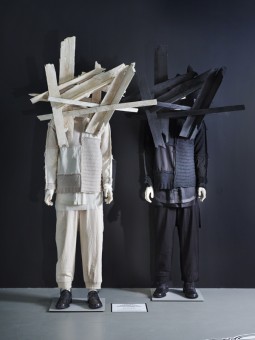
Following the series of great collaborations started in March 2013, the Centraal Museum Utrecht is the new curator of the Europeana Fashion Tumblr!
THE EDITOR’S COLUMN: MICRO/MACRO
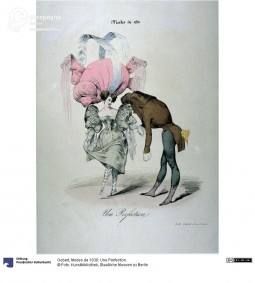 Fashion is not a matter of size; however, it is undeniable that, in fashion, size matters.We could argue that fashion temps out when relatively ‘raw’ materials are transformed into forms and volumes; this translation is both actual and visual: clothes and accessories are devices whose very aspect is what characterises them, and therefore, their dimension might attracts different kinds of attention.
Fashion is not a matter of size; however, it is undeniable that, in fashion, size matters.We could argue that fashion temps out when relatively ‘raw’ materials are transformed into forms and volumes; this translation is both actual and visual: clothes and accessories are devices whose very aspect is what characterises them, and therefore, their dimension might attracts different kinds of attention.Europeana Fashion Focus: Dress by Charles Worth, ca. 1882
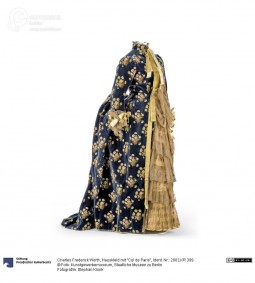
The dress is made of blue velvet, with a delicate floral pattern in different nuances of yellow, and lined in honey-coloured satin silk. The front presents a cascade of lace ruffs, The collar and the sleeves are also finished with silk ribbons and lace. It was designed and produced by the Maison Worth in Paris, around 1882.
The ‘Casacca’: Unisex by Emilio Pucci
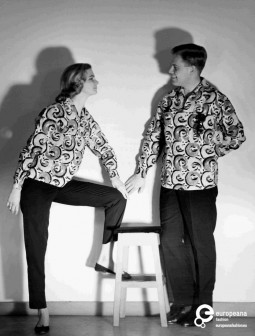
Celebrated as the king of prints, Florentine designer Emilio Pucci was not only a master of the decorate surface. Instead, the experimental nature that he expressed through his prints was as effective in his volumes and shapes as in his bright colours.
Vestirsi da Uomo: performing masculinity at Pitti
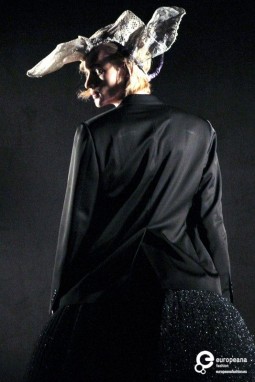
For its 80th edition in 2011, Fondazione Pitti Discovery launched 'Vestirsi da Uomo’ (Dress like a Man), a project focused on the exploration of the meanings and definitions of contemporary masculine elegance. To mark this event, both in 2011 and 2012 Pitti Discovery presented a reading of the theme which took the form of two highly reflective and striking performances, which played around the idea of gender being something performative and performable.





